 Kia Optima: SRS components and functions
Kia Optima: SRS components and functions
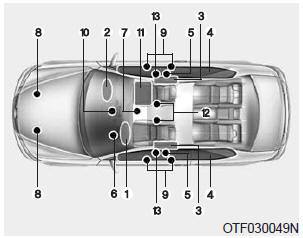
The SRS consists of the following components:
1. Driver's front air bag module
2. Passenger's front air bag module
3. Side
impact air bag modules
4. Curtain air bag modules
5. Retractor pre-tensioner
assemblies*
6. Air bag warning light
7. SRS control module (SRSCM)
8. Front
impact sensors
9. Side impact sensors
10. PASSENGER AIR BAG ŌĆ£OFFŌĆØ indicator
(Front passengerŌĆÖs seat only)
11. Occupant detection system (Front passengerŌĆÖs
seat only)
12. DriverŌĆÖs and front passengerŌĆÖs seat belt buckle sensors
13. Anchor
pre-tensioner assembly
*: if equipped
The SRSCM continually monitors all SRS components while the ignition switch is ON to determine if a crash impact is severe enough to require air bag deployment or pre-tensioner seat belt deployment.
The SRS air bag warning light on the instrument panel will illuminate for about 6 seconds after the ignition switch is turned to the ON position, after which the air bag warning light should go out. If any of the following conditions occurs, this indicates a malfunction of the SRS. Have an authorized Kia dealer inspect the air bag system as soon as possible.
- The light does not turn on briefly when you turn the ignition ON.
- The light stays on after illuminating for approximately 6 seconds.
- The light comes on while the vehicle is in motion.
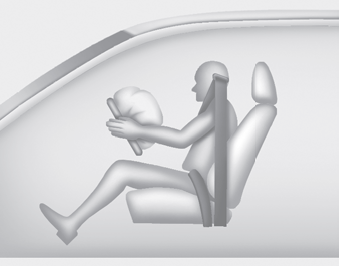
DriverŌĆÖs front air bag (1)
The air bag modules are located both in the center of the steering wheel and in the front passenger's panel above the glove box. When the SRSCM detects a sufficiently severe impact to the front of the vehicle, it will automatically deploy the front air bags.
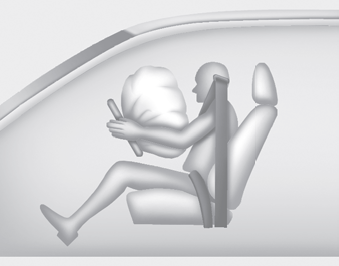
DriverŌĆÖs front air bag (2)
Upon deployment, tear seams molded directly into the pad covers will separate under pressure from the expansion of the air bags. Further opening of the covers then allows full inflation of the air bags.
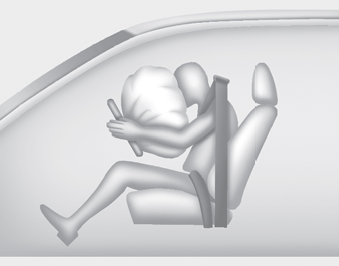
DriverŌĆÖs front air bag (3)
A fully inflated air bag, in combination with a properly worn seat belt, slows the driver's or the passenger's forward motion, reducing the risk of head and chest injury.
After complete inflation, the air bag immediately starts deflating, enabling the driver to maintain forward visibility and the ability to steer or operate other controls.
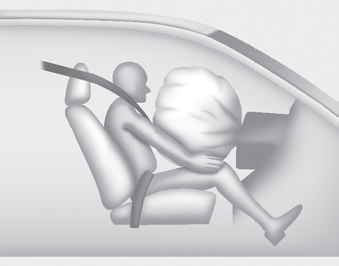
PassengerŌĆÖs front air bag
![]() WARNING
WARNING
- Do not install or place any accessories (drink holder, cassette holder, sticker, etc.) on the front passenger's panel above the glove box in a vehicle with a passenger's air bag. Such objects may become dangerous projectiles and cause injury if the passenger's air bag inflates.
- When installing a container of liquid air freshener inside the vehicle, do not place it near the instrument cluster nor on the instrument panel surface. It may become dangerous projectiles and cause injury if the passenger's air bag inflates.
![]() WARNING
WARNING
- If an air bag deploys, there may be a loud noise followed by a fine dust released in the vehicle. These conditions are normal and are not hazardous - the air bags are packed in this fine powder. The dust generated during air bag deployment may cause skin or eye irritation as well as aggravate asthma for some persons. Always wash all exposed skin areas thoroughly with lukewarm water and a mild soap after an accident in which the air bags were deployed.
- The SRS can function only when the ignition key is in the ON position. If the SRS air bag warning light does not illuminate, or continuously remains on after illuminating for about 6 seconds when the ignition switch is turned to the ON position, or after the engine is started, comes on while driving, the SRS is not working properly. If this occurs, have your vehicle immediately inspected by an authorized Kia dealer.
- Before you replace a fuse or disconnect a battery terminal, turn the ignition switch to the LOCK position and remove the ignition key. Never remove or replace the air bag related fuse(s) when the ignition switch is in the ON position. Failure to heed this warning will cause the SRS air bag warning light to illuminate.
 Air bag warning light
Air bag warning light
The purpose of the air bag warning light in your instrument panel is to alert
you of a potential problem with your air bag - Supplemental Restraint System (SRS).
When the ignition switch is turn ...
 ODS (Occupant Detection System)
ODS (Occupant Detection System)
Your vehicle is equipped with an ODS in the front passenger's seat.
The ODS is designed to detect the presence of a properly-seated front passenger
and determine if the passenger's front ...
See also:
If the engine overheats
If your temperature gauge indicates overheating,
you will experience a loss of
power, or hear loud pinging or knocking,
the engine is probably too hot. If this happens,
you should:
1. Pull of ...
Indicator symbols on the instrument cluster
...
Component location
1. Driveshaft (LH)
2. Driveshaft (RH)
1. Driveshaft (LH)
2. Circlip
3. Inner shaft bearing bracket assembly
4. Circlip
5. Driv ...
